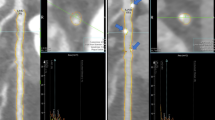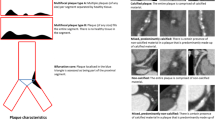Abstract
Objectives
Quantitative measurements of coronary plaque volume may play a role in serial studies to determine disease progression or regression. Our aim was to evaluate the interscan reproducibility of quantitative measurements of coronary plaque volumes using a standardized automated method.
Methods
Coronary dual source computed tomography angiography (CTA) was performed twice in 20 consecutive patients with known coronary artery disease within a maximum time difference of 100 days. The total plaque volume (TP), the volume of non-calcified plaque (NCP) and calcified plaque (CP) as well as the maximal remodelling index (RI) were determined using automated software.
Results
Mean TP volume was 382.3 ± 236.9 mm3 for the first and 399.0 ± 247.3 mm3 for the second examination (p = 0.47). There were also no significant differences for NCP volumes, CP volumes or RI. Interscan correlation of the plaque volumes was very good (Pearson’s correlation coefficients: r = 0.92, r = 0.90 and r = 0.96 for TP, NCP and CP volumes, respectively).
Conclusions
Automated software is a time-saving method that allows accurate assessment of coronary atherosclerotic plaque volumes in coronary CTA with high reproducibility. With this approach, serial studies appear to be possible.
Key Points
• Reproducibility of coronary atherosclerotic plaque volume in coronary CTA is high.
• Using automated software facilitates quantitative measurements.
• Serial studies to determine progression or regression of coronary plaque are possible.




Similar content being viewed by others
References
Taylor AJ, Cerqueira M, Hodgson JM, American College of Cardiology Foundation Appropriate Use Criteria Task Force, Society of Cardiovascular Computed Tomography; American College of Radiology, American Heart Association; American Society of Echocardiography, American Society of Nuclear Cardiology, North American Society for Cardiovascular Imaging, Society for Cardiovascular Angiography and Interventions, Society for Cardiovascular Magnetic Resonance et al (2010) ACCF/SCCT/ACR/AHA/ASE/ASNC/NASCI/SCAI/SCMR 2010 appropriate use criteria for cardiac computed tomography. A report of the American College of Cardiology Foundation Appropriate Use Criteria Task Force, the Society of Cardiovascular Computed Tomography, the American College of Radiology, the American Heart Association, the American Society of Echocardiography, the American Society of Nuclear Cardiology, the North American Society for Cardiovascular Imaging, the Society for Cardiovascular Angiography and Interventions, and the Society for Cardiovascular Magnetic Resonance. J Cardiovasc Comput Tomogr 4:e1–e33
Marwan M, Taher MA, El Meniawy K et al (2011) In vivo CT detection of lipid-rich coronary artery atherosclerotic plaques using quantitative histogram analysis: a head to head comparison with IVUS. Atherosclerosis 215:110–115
Min JK, Shaw LJ, Devereux RB et al (2007) Prognostic value of multidetector coronary computed tomographic angiography for prediction of all-cause mortality. J Am Coll Cardiol 50:1161–1170
Pundziute G, Schuijf JD, Jukema JW et al (2007) Prognostic value of multislice computed tomography coronary angiography in patients with known or suspected coronary artery disease. J Am Coll Cardiol 49:62–70
Gaemperli O, Valenta I, Schepis T et al (2008) Coronary 64-slice CT angiography predicts outcome in patients with known or suspected coronary artery disease. Eur Radiol 18:1162–1173
Hadamitzky M, Freissmuth B, Meyer T et al (2009) Prognostic value of coronary computed tomographic angiography for prediction of cardiac events in patients with suspected coronary artery disease. J Am Coll Cardiol Cardiovasc Imaging 2:404–411
Carrigan TP, Nair D, Schoenhagen P et al (2009) Prognostic utility of 64-slice computed tomography in patients with suspected but no documented coronary artery disease. Eur Heart J 30:362–371
Chow BJ, Wells GA, Chen L et al (2010) Prognostic value of 64-slice cardiac computed tomography severity of coronary artery disease, coronary atherosclerosis, and left ventricular ejection fraction. J Am Coll Cardiol 55:1017–1028
Goldstein JA, Chinnaiyan KM, Abidov A, CT-STAT Investigators et al (2011) The CT-STAT (coronary computed tomographic angiography for systematic triage of acute chest pain patients to treatment) trial. J Am Coll Cardiol 58:1414–1422
Kristensen TS, Kofoed KF, Kühl JT, Nielsen WB, Nielsen MB, Kelbæk H (2011) Prognostic implications of nonobstructive coronary plaques in patients with non-ST-segment elevation myocardial infarction: a multidetector computed tomography study. J Am Coll Cardiol 58:502–509
Russo V, Zavalloni A, Bacchi Reggiani ML et al (2010) Incremental prognostic value of coronary CT angiography in patients with suspected coronary artery disease. Circ Cardiovasc Imaging 3:351–359
Min JK, Feignoux J, Treutenaere J, Laperche T, Sablayrolles J (2010) The prognostic value of multidetector coronary CT angiography for the prediction of major adverse cardiovascular events: a multicenter observational cohort study. Int J Cardiovasc Imaging 26:721–728
Petretta M, Daniele S, Acampa W et al (2012) Prognostic value of coronary artery calcium score and coronary CT angiography in patients with intermediate risk of coronary artery disease. Int J Cardiovasc Imaging 28:1547–1556
Nance JW Jr, Schlett CL, Schoepf UJ et al (2012) Incremental prognostic value of different components of coronary atherosclerotic plaque at cardiac CT angiography beyond coronary calcification in patients with acute chest pain. Radiology 264:679–690
Alexanderson E, Canseco-León N, Iñarra F, Meave A, Dey D (2012) Prognostic value of cardiovascular CT: is coronary artery calcium screening enough? The added value of CCTA. J Nucl Cardiol 19:601–608
Soon KH, Kelly AM, Cox N et al (2007) Practicality, safety and accuracy of computed tomography coronary angiography in the evaluation of low TIMI-risk score chest pain patients: a pilot study. Emerg Med Australas 19:129–135
Mahabadi AA, Achenbach S, Burgstahler C et al (2010) Safety, efficacy, and indications of beta-adrenergic receptor blockade to reduce heart rate prior to coronary CT angiography. Radiology 257:614–623
Dey D, Schuhbaeck A, Min JK, Berman DS, Achenbach S (2013) Non-invasive measurement of coronary plaque from coronary CT angiography and its clinical implications. Expert Rev Cardiovasc Ther 11:1067–1077
Motoyama S, Kondo T, Sarai M et al (2007) Multislice computed tomographic characteristics of coronary lesions in acute coronary syndromes. J Am Coll Cardiol 50:319–326
Motoyama S, Sarai M, Harigaya H et al (2009) Computed tomographic angiography characteristics of atherosclerotic plaques subsequently resulting in acute coronary syndrome. J Am Coll Cardiol 54:49–57
Pflederer T, Marwan M, Schepis T et al (2010) Characterization of culprit lesions in acute coronary syndromes using coronary dual-source CT angiography. Atherosclerosis 211:437–244
Hoffmann U, Moselewski F, Nieman K et al (2006) Noninvasive assessment of plaque morphology and composition in culprit and stable lesions in acute coronary syndrome and stable lesions in stable angina by multidetector computed tomography. J Am Coll Cardiol 47:1655–1662
Ferencik M, Schlett CL, Ghoshhajra BB et al (2012) A computed tomography-based coronary lesion score to predict acute coronary syndrome among patients with acute chest pain and significant coronary stenosis on coronary computed tomographic angiogram. Am J Cardiol 110:183–189
Versteylen MO, Kietselaer BL, Dagnelie PC et al (2013) Additive value of semiautomated quantification of coronary artery disease using cardiac computed tomographic angiography to predict future acute coronary syndrome. J Am Coll Cardiol 61:2296–2305
Leber AW, Becker A, Knez A et al (2006) Accuracy of 64-slice computed tomography to classify and quantify plaque volumes in the proximal coronary system: a comparative study using intravascular ultrasound. J Am Coll Cardiol 47:672–677
Schepis T, Marwan M, Pflederer T et al (2010) Quantification of non-calcified coronary atherosclerotic plaques with dual-source computed tomography: comparison with intravascular ultrasound. Heart 96:610–615
Petranovic M, Soni A, Bezzera H et al (2009) Assessment of nonstenotic coronary lesions by 64-slice multidetector computed tomography in comparison to intravascular ultrasound: evaluation of nonculprit coronary lesions. J Cardiovasc Comput Tomogr 3:24–31
Brodoefel H, Burgstahler C, Heuschmid M et al (2009) Accuracy of dual-source CT in the characterisation of non-calcified plaque: use of a colour-coded analysis compared with virtual histology intravascular ultrasound. Br J Radiol 82:805–812
Brodoefel H, Burgstahler C, Sabir A et al (2009) Coronary plaque quantification by voxel analysis: dual-source MDCT angiography versus intravascular sonography. AJR Am J Roentgenol 192:W84–W89
Otsuka M, Bruining N, Van Pelt NC, Mollet NR, Ligthart JM, Vourvouri E, Hamers R, De Jaegere P, Wijns W, Van Domburg RT, Stone GW, Veldhof S, Verheye S, Dudek D, Serruys PW, Krestin GP, De Feyter PJ (2008) Quantification of coronary plaque by 64-slice computed tomography: a comparison with quantitative intracoronary ultrasound. Investig Radiol 43:314–321
Boogers MJ, Broersen A, van Velzen JE et al (2012) Automated quantification of coronary plaque with computed tomography: comparison with intravascular ultrasound using a dedicated registration algorithm for fusion-based quantification. Eur Heart J 33:1007–1016
Dey D, Schepis T, Marwan M, Slomka PJ, Berman DS, Achenbach S (2010) Automated three-dimensional quantification of noncalcified coronary plaque from coronary CT angiography: comparison with intravascular US. Radiology 257:516–522
Cademartiri F, Mollet NR, Runza G et al (2005) Influence of intracoronary attenuation on coronary plaque measurements using multislice computed tomography: observations in an ex vivo model of coronary computed tomography angiography. Eur Radiol 15:1426–1431
Halliburton SS, Schoenhagen P, Nair A et al (2006) Contrast enhancement of coronary atherosclerotic plaque: a high-resolution, multidetector-row computed tomography study of pressure-perfused, human ex-vivo coronary arteries. Coron Artery Dis 17:553–560
Maffei E, Martini C, Arcadi T et al (2012) Plaque imaging with CT coronary angiography: effect of intra-vascular attenuation on plaque type classification. World J Radiol 4:265–272
Cademartiri F, La Grutta L, Runza G et al (2007) Influence of convolution filtering on coronary plaque attenuation values: observations in an ex vivo model of multislice computed tomography coronary angiography. Eur Radiol 17:1842–1849
Achenbach S, Boehmer K, Pflederer T et al (2010) Influence of slice thickness and reconstruction kernel on the computed tomographic attenuation of coronary atherosclerotic plaque. J Cardiovasc Comput Tomogr 4:110–115
Øvrehus KA, Marwan M, Bøtker HE, Achenbach S, Nørgaard BL (2012) Reproducibility of coronary plaque detection and characterization using low radiation dose coronary computed tomographic angiography in patients with intermediate likelihood of coronary artery disease (ReSCAN study). Int J Cardiovasc Imaging 28:889–899
Cheng VY, Nakazato R, Dey D et al (2009) Reproducibility of coronary artery plaque volume and composition quantification by 64-detector row coronary computed tomographic angiography: an intraobserver, interobserver, and interscan variability study. J Cardiovasc Comput Tomogr 3:312–320
Achenbach S, Ropers D, Hoffmann U et al (2004) Assessment of coronary remodelling in stenotic and nonstenotic coronary atherosclerotic lesions by multidetector spiral computed tomography. J Am Coll Cardiol 43:842–847
Halliburton SS, Abbara S, Chen MY et al (2011) SCCT guidelines on radiation dose and dose-optimization strategies in cardiovascular CT. J Cardiovasc Comput Tomogr 5:198–224
Bongartz G, Golding SJ, Jurik AG et al. (2004) European guidelines for multislice computed tomography. Funded by the European Commission. Contract number FIGM-CT2000-20078-CT-TIP
McCollough C, Cody D, Edyvean S et al (2008) The measurement, reporting, and managment of radiation dose in CT. Report of AAPM Task Group 23 of the Diagnostic Imaging Council CT Committee. American Association of Physicists in Medicine, College Park, pp 1–28
Achenbach S, Moselewski F, Ropers D et al (2004) Detection of calcified and noncalcified coronary atherosclerotic plaque by contrast-enhanced, submillimeter multidetector spiral computed tomography: a segment-based comparison with intravascular ultrasound. Circulation 109:14–17
Acknowledgments
This study was supported by the German government, Bundesministerium für Bildung und Forschung (01EX1012B, Spitzencluster Medical Valley). The patient study at John Hopkins University was supported by a grant from Siemens Medical Solutions. The scientific guarantor of this publication is Damini Dey. The authors of this manuscript declare no relationships with any companies, whose products or services may be related to the subject matter of the article. No complex statistical methods were necessary for this paper. This study was approved by the institutional review board at each institution. The patients gave informed written consent for the use of their data for research. Methodology: retrospective, diagnostic or prognostic study, multicenter study.
Author information
Authors and Affiliations
Corresponding author
Rights and permissions
About this article
Cite this article
Schuhbaeck, A., Dey, D., Otaki, Y. et al. Interscan reproducibility of quantitative coronary plaque volume and composition from CT coronary angiography using an automated method. Eur Radiol 24, 2300–2308 (2014). https://doi.org/10.1007/s00330-014-3253-3
Received:
Revised:
Accepted:
Published:
Issue Date:
DOI: https://doi.org/10.1007/s00330-014-3253-3




